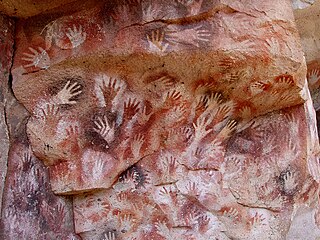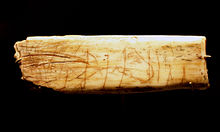
The Red "Lady" of Paviland is an Upper Paleolithic partial male skeleton dyed in red ochre and buried in Wales 33,000 BP. The bones were discovered in 1823 by William Buckland in an archaeological dig at Goat's Hole Cave which is a limestone cave between Port Eynon and Rhossili on the Gower Peninsula, near Swansea in south Wales. Buckland believed the skeleton was a Roman era female. Later, William Solace examined Goat's Cave Paviland in 1912. There, Solace found flint arrow heads and tools and correctly concluded that the skeleton was in fact a male hunter-gatherer or warrior during the last Ice Age.

In archaeology, cave paintings are a type of parietal art, found on the wall or ceilings of caves. The term usually implies prehistoric origin. These paintings were often created by Homo sapiens, but also Denisovans and Neanderthals; other species in the same Homo genus. Discussion around prehistoric art is important in understanding the history of the Homo sapiens species and how Homo sapiens have come to have unique abstract thoughts. Some point to these prehistoric paintings as possible examples of creativity, spirituality, and sentimental thinking in prehistoric humans.

Creswell Crags is an enclosed limestone gorge on the border between Derbyshire and Nottinghamshire, England, near the villages of Creswell and Whitwell. The cliffs in the ravine contain several caves that were occupied during the last ice age, between around 43,000 and 10,000 years ago. Its caves contain the northernmost cave art in Europe. The evidence of occupation found in the rich series of sediments that accumulated over many thousands of years is regarded as internationally unique in demonstrating how prehistoric people managed to live at the extreme northernmost limits of their territory during the Late Pleistocene period.

Sir William Boyd Dawkins was a British geologist and archaeologist. He was a member of the Geological Survey of Great Britain, Curator of the Manchester Museum and Professor of Geology at Owens College, Manchester. He is noted for his research on fossils and the antiquity of man. He was involved in many projects including a tunnel under the Humber, a Channel Tunnel attempt and the proving of coal under Kent.

The Creswellian is a British Upper Palaeolithic culture named after the type site of Creswell Crags in Derbyshire by Dorothy Garrod in 1926. It is also known as the British Late Magdalenian. According to Andreas Maier: "In current research, the Creswellian and Hamburgian are considered to be independent but closely related entities which are rooted in the Magdalenian." The Creswellian is dated between 13,000 and 11,800 BP and was followed by the most recent ice age, the Younger Dryas, when Britain was at times unoccupied by humans.

The Gravettian was an archaeological industry of the European Upper Paleolithic that succeeded the Aurignacian circa 33,000 years BP. It is archaeologically the last European culture many consider unified, and had mostly disappeared by c. 22,000 BP, close to the Last Glacial Maximum, although some elements lasted until c. 17,000 BP. In Spain and France, it was succeeded by the Solutrean and by the Epigravettian in Italy, the Balkans, Ukraine and Russia.

The Löwenmensch figurine, also called the Lion-man of Hohlenstein-Stadel, is a prehistoric ivory sculpture discovered in Hohlenstein-Stadel, a German cave, part of the Caves and Ice Age Art in the Swabian Jura UNESCO World Heritage Site, in 1939. The German name, Löwenmensch, meaning "lion-person" or "lion-human", is used most frequently because it was discovered and is exhibited in Germany. It is an anthropomorphic figurine combining a human-like body with the head of a cave lion.
Below are notable events in archaeology that occurred in 1876.

Cave hyena are extinct species or subspecies of hyena known from Eurasia, which ranged from Western Europe to eastern Asia and Siberia during the Pleistocene epoch. It is well represented in many European caves, primarily dating to the Last Glacial Period. It was an apex predator that preyed on large mammals, and was responsible for the accumulation of hundreds of large Pleistocene mammal bones in areas including horizontal caves, sinkholes, mud pits, and muddy areas along rivers.

Paleolithic religions are a set of spiritual beliefs and practices that are theorized to have appeared during the Paleolithic time period. Paleoanthropologists Andre Leroi-Gourhan and Annette Michelson believe unmistakably religious behavior emerged by the Upper Paleolithic, before 30,000 years ago at the latest, but behavioral patterns such as burial rites that one might characterize as religious — or as ancestral to religious behavior — reach back into the Middle Paleolithic, as early as 300,000 years ago, coinciding with the first appearance of Homo neanderthalensis and possibly Homo naledi.

The art of the Upper Paleolithic represents the oldest form of prehistoric art. Figurative art is present in Europe and Southeast Asia, beginning around 50,000 years ago. Non-figurative cave paintings, consisting of hand stencils and simple geometric shapes, are somewhat older, at least 40,000 years old, and possibly as old as 64,000 years. This latter estimate is due to a controversial 2018 study based on uranium-thorium dating, which would imply Neanderthal authorship and qualify as art of the Middle Paleolithic.

The Kendrick's Cave Decorated Horse Jaw is one of the finest pieces of portable artwork dated to the end of the last Ice Age or Late Glacial period that has been found in Britain. Others in Britain include the Robin Hood Cave Horse and the Pin Hole Cave man. It is the oldest known piece of portable art from Wales.

The Pinhole Cave Man or Pin Hole Cave Man is the common name for an engraving of a human figure on a woolly rhinoceros rib bone dating to the Upper Paleolithic that is now in the British Museum. In 1926, a woolly rhinoceros rib that was broken at both ends was found in Pin Hole Cave, Creswell Crags, Derbyshire, England.
Paul Barry Pettitt, FSA is a British archaeologist and academic. He specialises in the Palaeolithic era, with particular focus on claims of art and burial practices of the Neanderthals and Pleistocene Homo sapiens, and methods of determining the age of artefacts from this time. Since 2013, he has been Professor of Archaeology at Durham University. He previously taught at Keble College, Oxford and the University of Sheffield.

The abri de Cap Blanc is a prehistoric limestone rock shelter with Magdalenian animal sculptures. It is in the Marquay commune on the right bank of the Beune River, a few kilometers west of Eyzies-de-Tayac, in Dordogne.

The Vogelherd Cave is located in the eastern Swabian Jura, south-western Germany. This limestone karst cave came to scientific and public attention after the 1931 discovery of the Upper Palaeolithic Vogelherd figurines, attributed to paleo-humans of the Aurignacian culture. These miniature sculptures made of mammoth ivory rank among the oldest uncontested works of art of mankind. Because of the cultural importance of these sculptures and the cave's testimony to the development of Paleolithic art and culture, in 2017 the site became part of the UNESCO World Heritage Site called Caves and Ice Age Art in the Swabian Jura.

The La Garma cave complex is a parietal art-bearing paleoanthropological cave system in Cantabria, Spain. It is located just north of the village of Omoño, part of the municipality of Ribamontán al Monte. The cave complex is noted for one of the best preserved floors from the Paleolithic containing more than 4,000 fossils and more than 500 graphical units. It is part of the Cave of Altamira and Paleolithic Cave Art of Northern Spain World Heritage Site.
The Sherborne bone is a fragment of animal rib, with a horse's head engraved on it, once dated to the Palaeolithic period, but now generally viewed as a forgery as radiocarbon dating revealed it to be only about 700 years old. The bone was found in the rubble of a quarry near Sherborne in Dorset.

Gouy Cave is a cave with engravings dating to the paleolithic era in Gouy, France. It has the northernmost paleolithic cave art found in France.

















